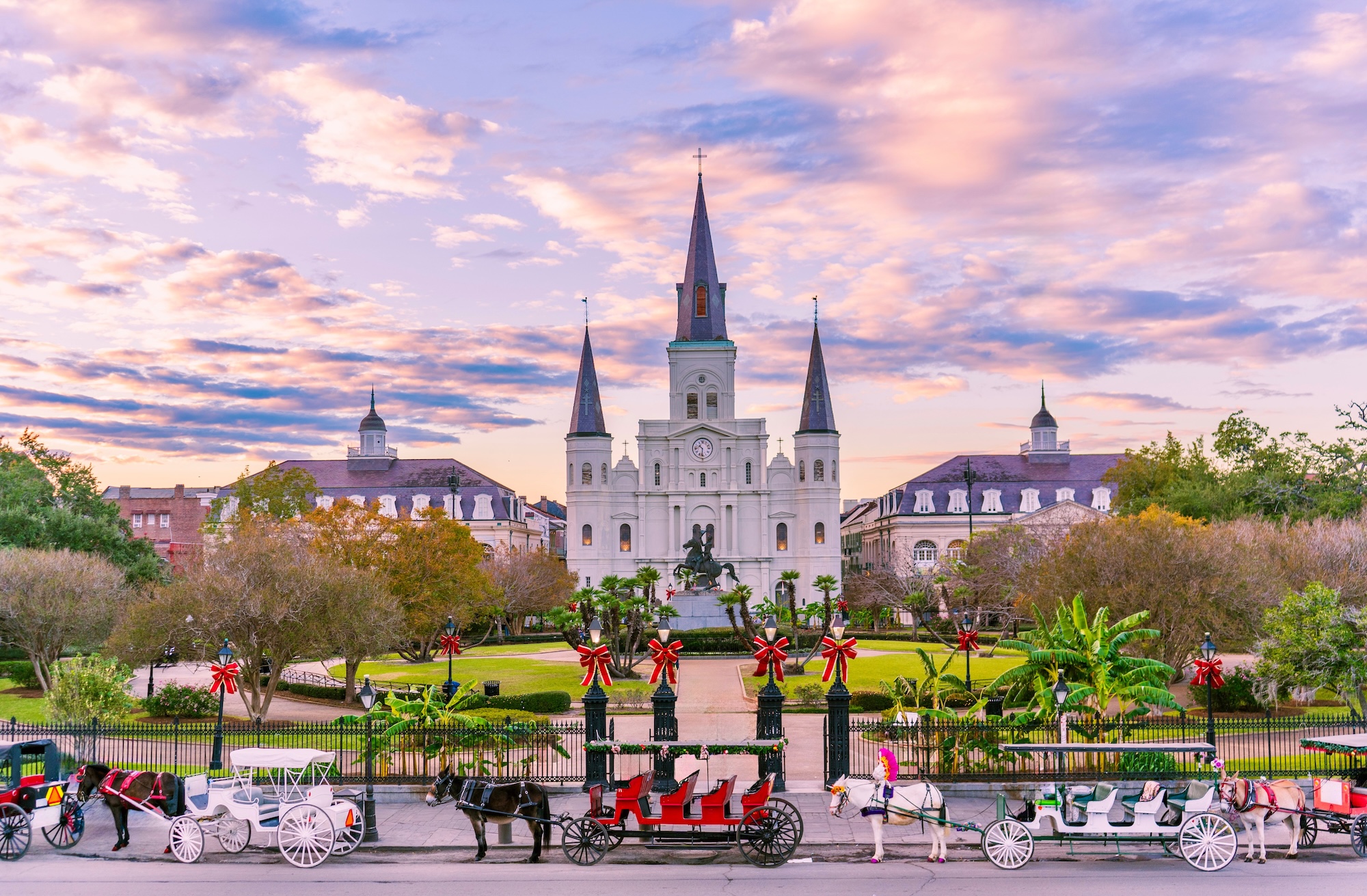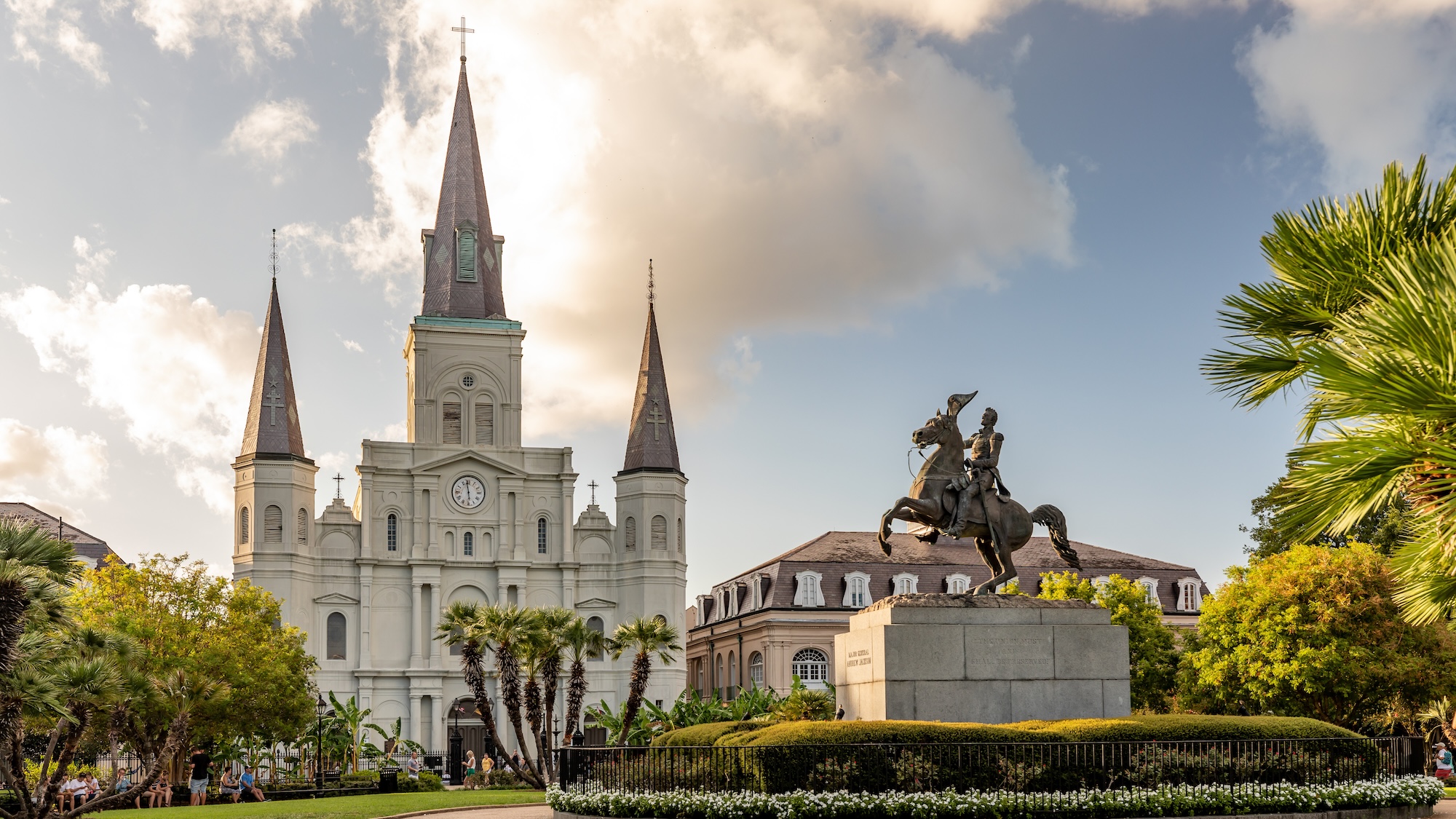
World Travel Tips
What Should You Do in New Orleans?
New Orleans is a city like no other—where centuries-old traditions, rich culture, and vibrant music fill the air. Known for its blend of French, African, and Creole heritage, this Southern gem offers visitors a lively mix of historic sites, unique neighborhoods, and unforgettable flavors. Whether you’re strolling through the French Quarter or soaking up jazz on Frenchmen Street, New Orleans is a place that’s meant to be experienced with all the senses. Here are the top 10 attractions you shouldn’t miss.
1. The French Quarter

At the heart of the city, The French Quarter is New Orleans’ oldest and most famous neighborhood. Cobblestone streets, lively bars, iron-laced balconies, and colorful Creole townhouses set the scene for a truly unique experience.
Why visit?
The French Quarter is the cultural soul of New Orleans. Whether you’re exploring vibrant Bourbon Street or the quieter corners lined with art galleries and jazz clubs, it’s the perfect place to dive into the city’s history, music, and nightlife.
2. Jackson Square

Surrounded by historic buildings, Jackson Square is a lively public space at the heart of the French Quarter, anchored by the striking St. Louis Cathedral.
Why visit?
Jackson Square is the perfect spot to soak in New Orleans’ local flavor. Street performers, artists, and musicians gather here daily, creating an energetic atmosphere that captures the city’s creative spirit.
3. St. Louis Cathedral

The iconic St. Louis Cathedral towers over Jackson Square and is one of the oldest continuously active cathedrals in the United States.
Why visit?
St. Louis Cathedral is a symbol of New Orleans’ history and spiritual heritage. Its stunning architecture, beautiful stained glass, and peaceful interior make it a must-see for history buffs and architecture lovers.
4. Garden District
Famed for its grand mansions and leafy avenues, the Garden District offers a picturesque escape from the city’s busier quarters.
Why visit?
Garden District is the place to admire classic Southern architecture and gorgeous gardens. Take a self-guided walking tour to spot historic homes and centuries-old oak trees draped in Spanish moss.
5. National WWII Museum
A world-class institution, the National WWII Museum takes visitors on a powerful journey through the history and impact of World War II.
Why visit?
National WWII Museum is ranked among the top museums in the country. Its interactive exhibits, immersive displays, and personal stories provide a moving and educational experience for visitors of all ages.
6. Frenchmen Street
A vibrant stretch just outside the French Quarter, Frenchmen Street is famed for its live music venues and buzzing nightlife.
Why visit?
Frenchmen Street is the place to experience New Orleans’ legendary jazz and blues scene. With music pouring out of nearly every bar and club, you’ll find talented performers and an unforgettable local vibe.
7. Steamboat Natchez
Cruise the Mississippi River in style aboard the Steamboat Natchez, a classic paddlewheeler offering scenic views and live jazz.
Why visit?
Steamboat Natchez lets you see New Orleans from a different perspective. Enjoy river breezes, Creole cuisine, and traditional jazz as you float past historic sites and the city skyline.
8. Audubon Park & Zoo
A lush oasis in Uptown, Audubon Park & Zoo features centuries-old oak trees, walking trails, and a world-class zoo.
Why visit?
Audubon Park & Zoo is perfect for families and nature lovers. Stroll through the beautiful park, visit exotic animals, or simply relax under the shade of ancient oaks.
9. Preservation Hall
A legendary music venue, Preservation Hall is dedicated to preserving traditional New Orleans jazz.
Why visit?
Preservation Hall is an intimate spot where you can experience live jazz played by some of the city’s best musicians. Its old-world charm and authentic atmosphere make for an unforgettable evening.
10. City Park
One of the oldest urban parks in the country, City Park offers sprawling green spaces, centuries-old oak trees, and top attractions like the New Orleans Museum of Art.
Why visit?
City Park is a peaceful retreat for outdoor activities, from paddle boating to exploring scenic trails. The park’s gardens, playgrounds, and art installations make it a favorite for both locals and visitors.
Seasonal Recommendations
🌸 🎭 Spring (March–May): Spring is the most popular and lively season in New Orleans, with average temperatures ranging from 65°F to 80°F (18°C to 27°C). The city bursts to life with festivals, including the world-famous Mardi Gras and Jazz Fest. Streets are filled with parades, music, and a festive energy you won’t find anywhere else. It’s the ideal time for a stroll through the French Quarter, picnics in Audubon Park & Zoo, or soaking up jazz on Frenchmen Street. Pleasant weather, blooming gardens, and a packed events calendar make spring unforgettable, but be sure to book hotels early as crowds are at their peak.
☀️ Summer (June–August): Summer in New Orleans is hot, humid, and energetic, with temperatures often between 75°F and 92°F (24°C to 33°C). While it’s the wettest season, the city buzzes with life—think lively street performances, river cruises on the Steamboat Natchez, and cool drinks in shaded courtyards. Afternoon thunderstorms are common but usually brief. This is a great time to enjoy air-conditioned attractions like the National WWII Museum or catch a live show at Preservation Hall. Expect fewer tourists and better hotel deals, but always plan for the heat and stay hydrated.
🍁 Autumn (September–November): Fall offers milder weather and thinner crowds, with temperatures averaging 65°F to 85°F (18°C to 29°C). It’s a favorite among locals for its comfortable days, cool evenings, and the return of food and music festivals. Autumn is ideal for exploring historic neighborhoods like the Garden District or enjoying leisurely walks through City Park beneath centuries-old oaks. The city’s vibrant energy returns after the summer lull, and outdoor dining and live music fill the streets without the springtime crowds.
❄️ Winter (December–February): Winter is New Orleans’ quietest season, with temperatures ranging from 48°F to 65°F (9°C to 18°C). The city is festive and cozy, decorated for the holidays and filled with seasonal celebrations. While Mardi Gras festivities kick off in late winter, early months are calmer—perfect for exploring the St. Louis Cathedral, discovering local art, or enjoying hearty Creole cuisine. You’ll find fewer tourists, shorter lines at top attractions, and plenty of charm, making winter a wonderful time for a more relaxed visit.
New Orleans Excursions
Tips for Your Visit
Getting Around
- Ride the Streetcar: New Orleans’ historic streetcars are a fun and scenic way to explore major neighborhoods like the French Quarter and Garden District. Get a Jazzy Pass for unlimited rides.
- Walk the French Quarter: The French Quarter and surrounding areas are best explored on foot, letting you enjoy hidden courtyards, live music, and local art at your own pace.
- Use Rideshares or Taxis at Night: While many areas are walkable, opt for a taxi or rideshare like Uber or Lyft if you’re out late or venturing farther from the city center.
Local Cuisine
- Don’t Miss Beignets: Start your day with hot, powdered-sugar beignets at the legendary Café du Monde or another local favorite.
- Sample Creole & Cajun Dishes: Try iconic New Orleans specialties like gumbo, jambalaya, crawfish étouffée, and po’boys from local restaurants or markets.
- Check Out Local Seafood: Enjoy fresh Gulf seafood, especially oysters and shrimp, often found in classic dishes throughout the city.
Language
- English is Widely Spoken: English is the primary language, but you may also hear some French phrases and distinctive local slang rooted in Creole and Cajun culture.
- Embrace the Local Lingo: Terms like “lagniappe” (a little something extra) and “the Big Easy” are part of everyday conversation. Don’t be afraid to ask locals about the meaning behind phrases!
Safety
- Stay in Well-Traveled Areas: Stick to popular neighborhoods, especially at night. The French Quarter, Garden District, and main tourist routes are generally safe and busy.
- Watch Your Belongings: As in any city, keep an eye on your bags and valuables in crowded places and during festivals or parades.
- Know Emergency Contacts: Dial 911 for any emergency, and don’t hesitate to ask for help from local authorities or business staff if you feel unsafe.
These tips will help you make the most of your New Orleans adventure, savor its world-famous flavors, and stay safe while exploring the city’s unique charm!
3 Popular Restaurants
The restaurant scene in New Orleans is renowned for its rich traditions, vibrant flavors, and blend of French, Creole, and Cajun influences. Whether you’re seeking classic Southern comfort or modern twists on local fare, these three restaurants stand out as the city’s most celebrated and sought-after dining destinations:
1. Commander’s Palace
Location: 1403 Washington Ave, New Orleans, LA 70130 View On Map
Cuisine: Creole, Contemporary Louisiana
Why It’s Popular: A true New Orleans icon, Commander’s Palace is beloved for its refined Creole cuisine, legendary hospitality, and historic setting in the Garden District. It’s famous for its jazz brunches, award-winning turtle soup, and inventive takes on classic Louisiana dishes. The restaurant’s elegant, lively atmosphere makes it a must-visit for both locals and tourists seeking an authentic New Orleans dining experience.
2. Cochon
Location: 930 Tchoupitoulas St Ste A, New Orleans, LA 70130 View On Map
Cuisine: Cajun Southern, Contemporary
Why It’s Popular: Cochon is celebrated for its bold, rustic Cajun flavors and its dedication to traditional Southern ingredients. Helmed by Chef Donald Link, the restaurant focuses on house-cured meats, wood-fired dishes, and specialties like pork cheeks and fried alligator. The bustling warehouse district setting and lively open kitchen draw food lovers eager for hearty, authentic Louisiana fare.
3. Galatoire’s
Location: 209 Bourbon St, New Orleans, LA 70130 View On Map
Cuisine: Classic Creole
Why It’s Popular: Galatoire’s is a cornerstone of French Quarter dining, known for its lively, old-school ambiance and traditional Creole dishes. Regulars and first-time visitors alike flock here for favorites like shrimp remoulade, crabmeat maison, and soufflé potatoes. The convivial atmosphere, storied history, and commitment to timeless recipes make Galatoire’s a quintessential New Orleans dining experience.
Tips for Dining in New Orleans
New Orleans is a city where the food is as soulful and storied as the jazz music echoing through its streets. The city’s culinary traditions blend French, Creole, Cajun, and African influences, resulting in a food scene that’s both historic and endlessly creative. Whether you’re slurping oysters in the French Quarter or sampling po’boys at a neighborhood joint, these tips will help you savor every bite and make the most of your dining experience in the Crescent City.
Important: Is New Orleans Tap Water Safe to Drink?
New Orleans’ tap water is generally safe to drink and meets federal and state standards. It’s sourced from the Mississippi River and treated by the local Sewerage and Water Board. Many restaurants serve tap water as the default, but you’ll also find bottled water widely available.
Tip: For most visitors, there’s no need to avoid tap water in New Orleans, especially when dining at reputable establishments that follow health codes and maintain clean facilities. However, some locals and travelers prefer bottled water for taste or peace of mind, particularly in older buildings with outdated plumbing.
1. Don’t Miss the Classics
Dishes like gumbo, jambalaya, red beans and rice, crawfish étouffée, and beignets are New Orleans staples—each with its own story.
Tip: Try iconic spots like Café du Monde for beignets, Commander’s Palace for Creole cuisine, and Coop’s Place for hearty jambalaya.
2. Expect to Wait at Popular Restaurants
Legendary eateries and breakfast spots (think Brennan’s or Mother’s) can draw long lines, especially during peak times or festival weekends.
Tip: Make reservations when possible, arrive early, or plan to explore nearby bars or shops while you wait for a table.
3. Dress Codes Are a Thing
Fine-dining restaurants in New Orleans often have dress codes, especially for dinner service.
Tip: “Business casual” is a safe bet at many upscale spots. When in doubt, check the restaurant’s website for details before you go.
4. Enjoy Local Seafood—But Mind the Season
From Gulf shrimp to oysters and crawfish, New Orleans is a seafood lover’s paradise. But availability can change with the seasons.
Tip: Crawfish is best in spring, while oysters are traditionally enjoyed in cooler months. Ask your server what’s fresh and in season.
5. Embrace the Casual (and the Late-Night) Eats
Some of the best food in New Orleans comes from casual corner spots, po’boy shops, or 24-hour diners.
Tip: Don’t overlook legendary late-night spots like Verti Marte or Camellia Grill, where you can get a hearty meal well past midnight.
6. Check for Lagniappe (“A Little Something Extra”)
The spirit of lagniappe—a little something extra—runs deep in New Orleans hospitality.
Tip: You might get a complimentary appetizer, extra beignets, or even a small dessert “on the house” at many local establishments.
7. Try a “Go Cup” for Drinks
New Orleans has famously relaxed rules about carrying drinks in public—just pour it in a plastic “go cup.”
Tip: Many bars and restaurants will happily provide a go cup if you want to take your cocktail to go. Just don’t use glass containers on the street.
8. Tipping is Customary
Tipping is an essential part of dining culture in New Orleans, as in most of the U.S.
Tip: Leave 18–20% of your bill for good service. Double-check your receipt; some high-end spots include gratuity automatically.
9. Explore Neighborhood Gems
The French Quarter gets a lot of attention, but some of the city’s best food is in neighborhoods like Uptown, the Bywater, and Mid-City.
Tip: Try neighborhood favorites like Jacques-Imo’s, Mandina’s, or Turkey and the Wolf for unforgettable meals off the tourist trail.
10. Don’t Skip Dessert
From bread pudding soaked in whiskey sauce to classic pralines and bananas Foster, dessert in New Orleans is a must.
Tip: Treat yourself at Brennan’s, Antoine’s, or Loretta’s Authentic Pralines—and don’t leave town without a few beignets!
Conclusion
Dining in New Orleans is more than just a meal—it’s a celebration of culture, history, and hospitality. Whether you’re feasting on seafood in a historic dining room or enjoying a po’boy at a neighborhood dive, keep an open mind and a big appetite. With these tips, you’ll be ready to taste the best that the Crescent City has to offer. Bon appétit, or as the locals say, laissez les bon temps rouler!








